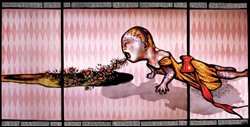JUDITH SCHAECHTER
Taking the medieval narrative panel as her launching pad, this stained glass artist creates sappy, violent, and just plain weird vignettes of early 21st century life. Her recurrent themes are road kill, bathrooms, naughty women, children, and other tragedies, all executed in absolutely gorgeous swirling, fractured bits of color. The scenes are sometimes syrupy, sometimes bitter but for the most part sincerely affecting (one piece that manages to be all three is Child Bride, above). This show is a bit tamer than some of her previous work, which has included titles such as Murder and Child, At Her Best Down on Both Knees, and Lucifer Poops. Which brings me to the Museum’s almost apologetic approach to this show. We’re assured by MOG that “the graphic nature of her work promotes reflection in her viewers, not the numbness of more popular forms of entertainment.” Well that’s a relief. The Museum then gingerly advises us that the real strength of this show is Schaechter’s technical skill. Bullshit. Yeah, she can make gorgeous glass, but it’s like Susan Sontag once said: Great art should make us nervous. Kudos to the Museum for taking on this show—no need to apologize. Reception (museum members only): 6 p.m.-8 p.m. Fri. Apr. 2. Artist Lecture: 2 p.m. Sun. Apr. 4. Museum of Glass, 1801 East Dock St. Tacoma, 253-396-1768. 10 a.m.-5 p.m. Wed.-Sat., noon-5 p.m. Sun. ANDREW ENGELSON
LAURIE LE CLAIR AND SUSAN SEUBERT
This smart coupling pairs two artists who explore time’s passage in innovative ways. Seubert, whose chilling photographic series, “Ten most popular places to dump a body in the Columbia River (Gorge),” is currently on view at the Tacoma Art Museum, continues to produce work with a hint of the macabre. Here she works with tintypes—small-format photographic images that were popular in the late 19th century and often mounted in jewelry. Her series of dresses, bloomers and corsets, seem to be receding from view, even while in plain sight; the fruit in her images turns to dust before us, even as they’re captured in a just-ripe state. In Le Clair’s ”Benediction” series, eight paintings on burlap portray the geographical remnants of disaster, though the titles—such as Grace, Providence, and Bounty—suggest more mystical remains. The show has the feel of a cautionary tale whose advice is lost on the wind. Yet for all the trouble brewing I felt better upon leaving the gallery than I did on arrival. Reception and gallery talk: 3 p.m. Sat. April 3. G. Gibson Gallery, 514 E. Pike St., 206-587-4033. 11 a.m.-6 p.m. Wed.-Fri., 11 a.m.-5 p.m. Sat. SUZANNE BEAL
ALLAN PACKER
It’s hard to explain the attraction of Packer’s recent “Sprue” paintings and sculptures if you’ve never built a model airplane. The little molded plastic frames (known as “sprues”) that contain the assorted model pieces have become something of an idée fixe for Packer. One life-sized sprue, for instance, sports an array of women’s body parts (cast from the real thing), while others include a ready-made Northwest forest (complete with clearcut stumps) and gorgeously carved wooden warships. It’s another example of art attempting to co-opt the mass-produced, but Packer has taken it a level further, making sprues a kind of touchstone, a symbol of some sort of Platonic ideal. It’s almost Nicholson Baker-esque in its obsessive attention to the unnoticed. I’ll admit there’s some nostalgia in it for me, too…I can almost smell that airplane glue again. Opening reception: 6 p.m.-8 p.m. Thurs. April 1. Davidson Galleries, 313 Occidental Ave. S., 206-624-7684. ANDREW ENGELSON





